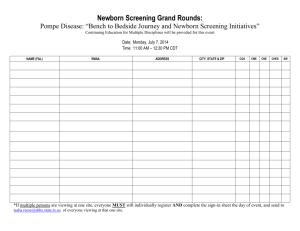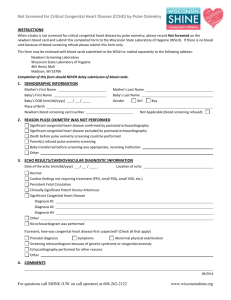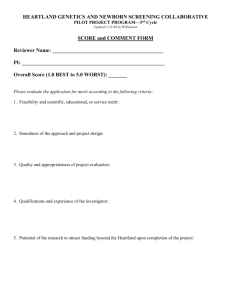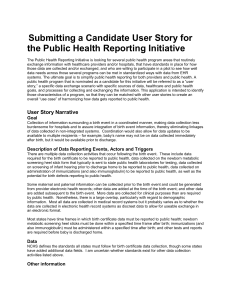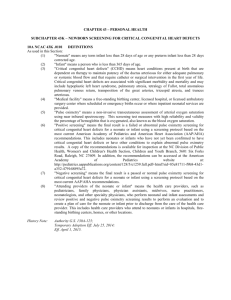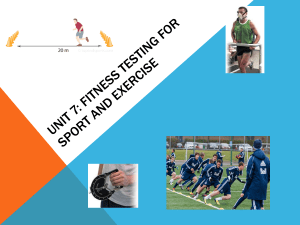Newborn Pulse Oximetry Screenings
advertisement
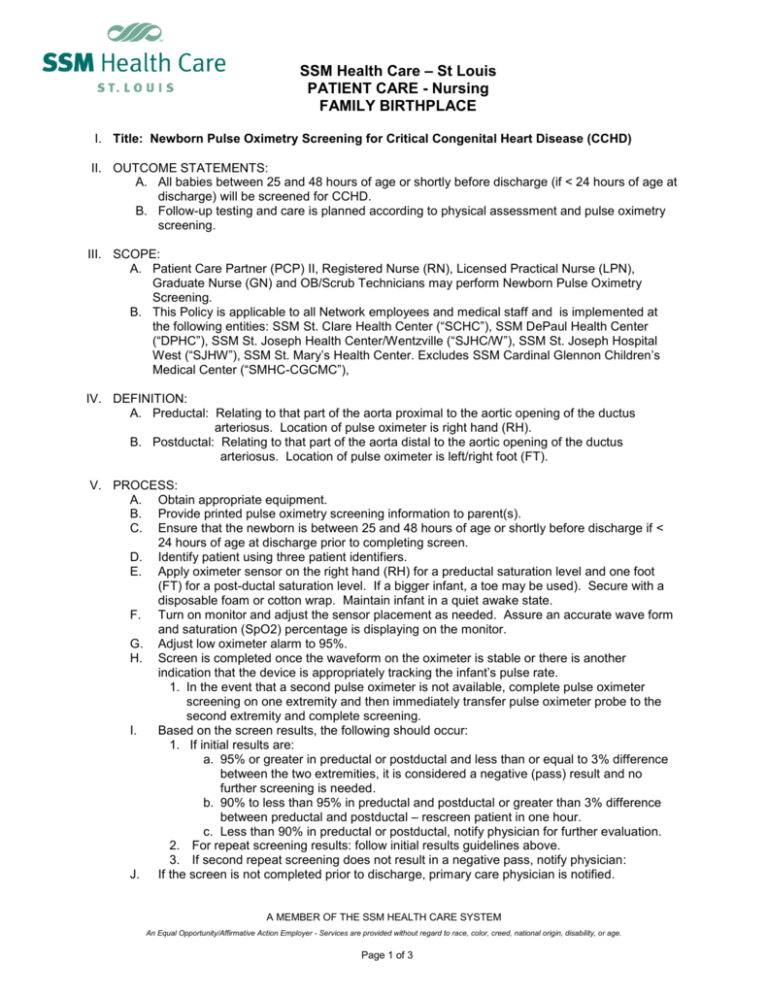
SSM Health Care – St Louis PATIENT CARE - Nursing FAMILY BIRTHPLACE I. Title: Newborn Pulse Oximetry Screening for Critical Congenital Heart Disease (CCHD) II. OUTCOME STATEMENTS: A. All babies between 25 and 48 hours of age or shortly before discharge (if < 24 hours of age at discharge) will be screened for CCHD. B. Follow-up testing and care is planned according to physical assessment and pulse oximetry screening. III. SCOPE: A. Patient Care Partner (PCP) II, Registered Nurse (RN), Licensed Practical Nurse (LPN), Graduate Nurse (GN) and OB/Scrub Technicians may perform Newborn Pulse Oximetry Screening. B. This Policy is applicable to all Network employees and medical staff and is implemented at the following entities: SSM St. Clare Health Center (“SCHC”), SSM DePaul Health Center (“DPHC”), SSM St. Joseph Health Center/Wentzville (“SJHC/W”), SSM St. Joseph Hospital West (“SJHW”), SSM St. Mary’s Health Center. Excludes SSM Cardinal Glennon Children’s Medical Center (“SMHC-CGCMC”), IV. DEFINITION: A. Preductal: Relating to that part of the aorta proximal to the aortic opening of the ductus arteriosus. Location of pulse oximeter is right hand (RH). B. Postductal: Relating to that part of the aorta distal to the aortic opening of the ductus arteriosus. Location of pulse oximeter is left/right foot (FT). V. PROCESS: A. Obtain appropriate equipment. B. Provide printed pulse oximetry screening information to parent(s). C. Ensure that the newborn is between 25 and 48 hours of age or shortly before discharge if < 24 hours of age at discharge prior to completing screen. D. Identify patient using three patient identifiers. E. Apply oximeter sensor on the right hand (RH) for a preductal saturation level and one foot (FT) for a post-ductal saturation level. If a bigger infant, a toe may be used). Secure with a disposable foam or cotton wrap. Maintain infant in a quiet awake state. F. Turn on monitor and adjust the sensor placement as needed. Assure an accurate wave form and saturation (SpO2) percentage is displaying on the monitor. G. Adjust low oximeter alarm to 95%. H. Screen is completed once the waveform on the oximeter is stable or there is another indication that the device is appropriately tracking the infant’s pulse rate. 1. In the event that a second pulse oximeter is not available, complete pulse oximeter screening on one extremity and then immediately transfer pulse oximeter probe to the second extremity and complete screening. I. Based on the screen results, the following should occur: 1. If initial results are: a. 95% or greater in preductal or postductal and less than or equal to 3% difference between the two extremities, it is considered a negative (pass) result and no further screening is needed. b. 90% to less than 95% in preductal and postductal or greater than 3% difference between preductal and postductal – rescreen patient in one hour. c. Less than 90% in preductal or postductal, notify physician for further evaluation. 2. For repeat screening results: follow initial results guidelines above. 3. If second repeat screening does not result in a negative pass, notify physician: J. If the screen is not completed prior to discharge, primary care physician is notified. A MEMBER OF THE SSM HEALTH CARE SYSTEM An Equal Opportunity/Affirmative Action Employer - Services are provided without regard to race, color, creed, national origin, disability, or age. Page 1 of 3 Newborn Pulse Oximetry Screening VI. DOCUMENTATION: A. Clinician Communication B. Newborn Daily Documentation Flowsheet C. Plan of Care D. Patient Education VII. PARTICIPATING DEPARTMENTS: A. Family Birthplace Nursing Staff B. Department of Pediatrics C. Department of Neonatology D. Physician staff VIII. REFERENCES: A. Kemper, A. R., Mahle, W. T., Martin, G. R., Cooley, C., Kumar, P., Morrow, W. R., Kelm, K., Pearson, G. D., Glidewell, J., Grosee, S. D. and Howell, R. R. (2011). Strategies for Implementing Screening for Critical Congenital Heart Disease. Pediatrics 128(5) B. Mahle, W.T., Newburger, J.W., Matherne, G.P., Smith, FC, Hoke, T.R., Koppel, R., Gidding, S.S., Beekman, R.H. 3rd, Grosse, S.D.; American Heart Association Congenital Heart Defects Committee of the Council on Cardiovascular Disease in the Young, Council on Cardiovascular Nursing, and Interdisciplinary Council on Quality of Care and Outcomes Research; American Academy of Pediatrics Section on Cardiology and Cardiac Surgery, and Committee on Fetus and Newborn (2009). Role of Pulse Oximetry in Examining Newborns for Congenital Heart Disease: A Scientific Statement from the American Heart Association and American Academy of Pediatrics, Circulation 120, pp 447-458. C. Attachment: Newborn Pulse Oximetry Screening Algorithm IX. FILE MAINTENANCE INFORMATON: Original Date: 09/2011 Revision Dates: 10/2012 Review Date: Loaded to Website: 10/2012 Authors: SSM St. Louis Network OB Practice Council Reviewed by: SSM St. Louis Network Practice Council, SSM St. Louis Department of Neonatology A MEMBER OF THE SSM HEALTH CARE SYSTEM An Equal Opportunity/Affirmative Action Employer - Services are provided without regard to race, color, creed, national origin, disability, or age. Page 2 of 3 Newborn Pulse Oximetry Screening Newborn Pulse Oximetry Screening Algorithm Verify patient is 25 - 48 hours of 95% age or shortly before discharge (if discharge less than 24 hours of age Screen <90% in RH or FT. Notify physician. 90% -< 95% in RH and FT or > 3% difference between RH and FT. > 95% in RH or FT and < 3% difference between RH and FT Repeat screen in one hour <90% in RH or FT. Notify physician. 90% -< 95% in RH and FT or > 3% difference between RH and FT. > 95% in RH or FT and < 3% difference between RH and FT Repeat screen in one hour <90% in RH or FT. Notify physician. 90% -< 95% in RH and FT or > 3% difference between RH and FT. Notify physician. Positive screen > 95% in RH or FT and < 3% difference between RH and FT Negative screen A MEMBER OF THE SSM HEALTH CARE SYSTEM An Equal Opportunity/Affirmative Action Employer - Services are provided without regard to race, color, creed, national origin, disability, or age. Page 3 of 3

